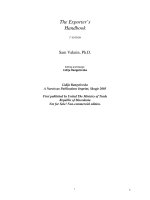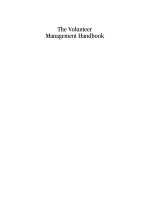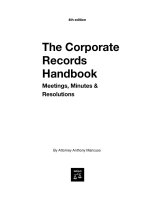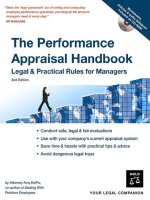THE var IMPLEMENTATION HANDBOOK GREG n GREGORIOU
Bạn đang xem bản rút gọn của tài liệu. Xem và tải ngay bản đầy đủ của tài liệu tại đây (3.82 MB, 561 trang )
Advance Praise for The VaR
Implementation Handbook
A valuable survey of the latest developments in VaR methodology.
This book will be of interest to both academics and practitioners
working in the arcane field of financial market risk management.
—Professor Moorad Choudhry, Department of Economics, London
Metropolitan University
The current VAR book edited by Professor Gregoriou is a serious and
well-thought contribution to the finance academic literature. Today
Value-at-Risk is considered by many academics as an immense area of
research with continued explosive growth. The content of the book is
designed to advance the knowledge of scholars worldwide, while guiding
practitioners through the modern techniques of risk measurement.
—Dr. Sotiris K. Staikouras, Associate Professor of Banking &
Finance and Director Undergraduate Programmes, Cass Business
School, London
This timely book contains in-depth analyses of VaR measurement and
modeling, as well as useful discussions of various managerial
applications. I highly recommend this book for anyone wanting to
deepen their understanding of VaR theory and practice.
—Paul Brockman, Matteson Professor of Financial Services,
University of Missouri, College of Business
To successfully manage even the strongest market turbulences like
the subprime credit crises market participants need efficient
instruments to continuously measure their risk. This book perfectly
helps practitioners to qualify and to quantify the specific types of risk
exposure by providing the tools for modelling the uncertainties
inherent in their portfolios. However,Value at Risk is a value adding
compendium not only in difficult times.”
—Christian Hoppe, Senior Specialist Securitization and
Credit Derivatives, Commerzbank AG
This book provides a broad overview of different Value-at-Risk
applications for the banking and insurance sector as well as for the
portfolio management especially for alternative investments.
Professor Gregoriou has collected an excellent composition of articles
which feature advanced Value-at-Risk applications and their usage in
different fields of the financial industry.
—Oliver Schwindler, Investment Analyst Hedge Funds at Feri
Institutional Advisors GmbH
THE VaR
IMPLEMENTATION
HANDBOOK
This page intentionally left blank
THE VaR
IMPLEMENTATION
HANDBOOK
GREG N. GREGORIOU
EDITOR
New York Chicago San Francisco
Lisbon London Madrid Mexico City
Milan New Delhi San Juan Seoul
Singapore Sydney Toronto
Copyright © 2009 by The McGraw-Hill Companies, Inc. All rights reserved. Except as permitted
under the United States Copyright Act of 1976, no part of this publication may be reproduced or
distributed in any form or by any means, or stored in a database or retrieval system, without the prior
written permission of the publisher.
ISBN: 978-0-07-161514-3
MHID: 0-07-161514-8
The material in this eBook also appears in the print version of this title: ISBN: 978-0-07-161513-6,
MHID: 0-07-161513-X.
All trademarks are trademarks of their respective owners. Rather than put a trademark symbol after
every occurrence of a trademarked name, we use names in an editorial fashion only, and to the
benefit of the trademark owner, with no intention of infringement of the trademark. Where such
designations appear in this book, they have been printed with initial caps.
McGraw-Hill eBooks are available at special quantity discounts to use as premiums and sales
promotions, or for use in corporate training programs. To contact a representative please visit the
Contact Us page at www.mhprofessional.com.
This publication is designed to provide accurate and authoritative information in regard to the subject
matter covered. It is sold with the understanding that neither the author nor the publisher is engaged
in rendering legal, accounting, futures/securities trading, or other professional service. If legal advice
or other expert assistance is required, the services of a competent professional person should be
sought.
—From a Declaration of Principles jointly adopted by a Committee of the American Bar Association
and a Committee of Publishers
TERMS OF USE
This is a copyrighted work and The McGraw-Hill Companies, Inc. (“McGraw-Hill”) and its licensors
reserve all rights in and to the work. Use of this work is subject to these terms. Except as permitted
under the Copyright Act of 1976 and the right to store and retrieve one copy of the work, you may not
decompile, disassemble, reverse engineer, reproduce, modify, create derivative works based upon,
transmit, distribute, disseminate, sell, publish or sublicense the work or any part of it without McGrawHill’s prior consent. You may use the work for your own noncommercial and personal use; any other
use of the work is strictly prohibited. Your right to use the work may be terminated if you fail to
comply with these terms.
THE WORK IS PROVIDED “AS IS.” McGRAW-HILL AND ITS LICENSORS MAKE NO
GUARANTEES OR WARRANTIES AS TO THE ACCURACY, ADEQUACY OR COMPLETENESS OF OR RESULTS TO BE OBTAINED FROM USING THE WORK, INCLUDING ANY
INFORMATION THAT CAN BE ACCESSED THROUGH THE WORK VIA HYPERLINK OR
OTHERWISE, AND EXPRESSLY DISCLAIM ANY WARRANTY, EXPRESS OR IMPLIED,
INCLUDING BUT NOT LIMITED TO IMPLIED WARRANTIES OF MERCHANTABILITY OR
FITNESS FOR A PARTICULAR PURPOSE. McGraw-Hill and its licensors do not warrant or guarantee that the functions contained in the work will meet your requirements or that its operation will be
uninterrupted or error free. Neither McGraw-Hill nor its licensors shall be liable to you or anyone else
for any inaccuracy, error or omission, regardless of cause, in the work or for any damages resulting
therefrom. McGraw-Hill has no responsibility for the content of any information accessed through the
work. Under no circumstances shall McGraw-Hill and/or its licensors be liable for any indirect,
incidental, special, punitive, consequential or similar damages that result from the use of or inability
to use the work, even if any of them has been advised of the possibility of such damages. This
limitation of liability shall apply to any claim or cause whatsoever whether such claim or cause arises
in contract, tort or otherwise.
C O N T E N T S
EDITOR xv
CONTRIBUTORS xvii
PART ONE
VaR MEASUREMENT
Chapter 1
Calculating VaR for Hedge Funds 3
Monica Billio, Mila Getmansky, and Loriana Pelizzon
Introduction 4
Hedge Funds 5
Value at Risk 6
Data 13
Results and Discussion 14
Conclusion 20
References 20
Appendix: Strategic Decisions 22
Chapter 2
Efficient VaR: Using Past Forecast Performance to
Generate Improved VaR Forecasts 25
Kevin Dowd and Carlos Blanco
Introduction 25
A Backtesting Framework 27
Using Backtest Results to Recalibrate the Parameters of the VaR Model 29
Some Examples 31
Conclusion 36
References 37
Appendix 38
v
vi
Contents
Chapter 3
Applying VaR to Hedge Fund Trading Strategies:
Limitations and Challenges 41
R. McFall Lamm, Jr.
Introduction 41
Background 43
Analytical Approach 44
Application Considerations 46
Impact of VaR Control 47
Short versus Long History for Setting VaR Risk Limits 51
Implications 53
Conclusion 55
References 56
Chapter 4
Cash Flow at Risk: Linking Strategy and Finance 59
Ulrich Hommel
Introduction 59
A Process View of the Corporate Risk Management Function 62
Value-Based Motives of Firm-Level Risk Management 66
The Incompatibility of Simple Value at Risk with
Corporate Risk Management 70
Operationalizing CFaR 72
Governance Implications 78
Conclusion 80
References 81
Chapter 5
Plausible Operational Value-at-Risk Calculations for
Management Decision Making 85
Wilhelm Kross, Ulrich Hommel, and Martin Wiethuechter
Introduction 85
Operational Risk under Basel II 86
Desirable Side Effects of Operational Risk Initiatives 91
Toward Strategy-Enhancing Operational Risk Initiatives 95
Employment of Real Option Techniques in Operational Risk Initiatives
99
Contents
vii
Conclusion 102
References 103
Chapter 6
Value-at-Risk Performance Criterion: A Performance
Measure for Evaluating Value-at-Risk Models 105
Zeno Adams and Roland Füss
Introduction 106
Value-at-Risk Performance Criterion (VPC) 107
Effects of Changing Volatility and Return Distribution
Conclusion 115
References 119
109
Chapter 7
Explaining Cross-Sectional Differences in Credit
Default Swap Spreads: An Alternative Approach
Using Value at Risk 121
Bastian Breitenfellner and Niklas Wagner
Introduction 122
Estimation Methodology 126
Data and Explanatory Variables 128
Empirical Results 131
Conclusion 135
References 135
Chapter 8
Some Advanced Approaches to VaR Calculation
and Measurement 139
François-Éric Racicot and Raymond Théoret
Introduction 139
Parametric VaR and the Normal Distribution 141
Using Historical Simulation to Compute VaR 142
The Delta Method for Computing VaR 145
The Monte Carlo Simulation 147
The Bootstrapping Method 149
Cornish-Fisher Expansion and VaR 155
viii
Value at Risk for a Distribution Other Than the Normal but
Using a Normal Coefficient 156
Copulas, Fourier’s Transform, and the VaR 157
Conclusion 162
References 163
Chapter 9
Computational Aspects of Value at Risk 167
Germán Navarro and Ignacio Olmeda
Introduction 168
Supercomputing Technologies 169
Graphics Processing Unit Computing 171
An Example 174
Conclusion 182
References 182
PART 2
RISK AND ASSET MANAGEMENT
Chapter 10
Value-at-Risk–Based Stop-Loss Trading 187
Bernd Scherer
Introduction 188
Stop-Loss Rules for Alternative Return Processes 189
Some Well-known Strategies 192
Conditional Autocorrelation: Threshold Autoregressive Models 196
Conclusion 202
References 203
Appendix: Currency Universe and Data Availability 205
Chapter 11
Modeling Portfolio Risks with Time-Dependent
Default Rates in Venture Capital 207
Andreas Kemmerer, Jan Rietzschel, and Henry Schoenball
Introduction 208
Contents
Contents
ix
Initial Model 208
Risk Modeling with Time-Dependent Default Rates 215
Empirical Evidence 220
Conclusion 226
References 226
Chapter 12
Risk Aggregation and Computation of Total Economic Capital 229
Peter Grundke
Introduction 229
Additive Approach 232
Correlation-Based Square-Root Formula 232
Top-Down Approach 233
Bottom-Up Approach 240
Conclusion 241
References 247
Chapter 13
Value at Risk for High-Dimensional Portfolios:
A Dynamic Grouped t-Copula Approach 253
Dean Fantazzini
Introduction 254
Dynamic Grouped t-Copula Modeling: Definition and Estimation
Simulation Studies 259
Empirical Analysis 271
Conclusion 277
References 279
Appendix: List of Analyzed Stocks 282
256
Chapter 14
A Model to Measure Portfolio Risks in Venture Capital 283
Andreas Kemmerer
Introduction 284
Toward a Risk Model in Venture Capital 285
A Risk Model for Venture Capital 290
x
Data Sample 297
Empirical Evidence
Conclusion 308
References 308
Contents
299
Chapter 15
Risk Measures and Their Applications in Asset Management 311
S. Ilker Birbil, Hans Frenk, Bahar Kaynar, and Nilay Noyan
Introduction 312
Risk Measures 315
A Single-Period Portfolio Optimization Problem 320
Elliptical World 324
Modified Michelot Algorithm 328
Computational Results 331
Conclusion 336
References 336
Chapter 16
Risk Evaluation of Sectors Traded at the ISE
with VaR Analysis 339
Mehmet Orhan and Gökhan Karaahmet
Introduction 339
Value-at-Risk Comparison of Sectors Traded at the
Istanbul Stock Exchange (ISE) 343
Performance of VaR in Evaluating Risk 350
Conclusion 356
References 357
PART THREE
MODELING
Chapter 17
Aggregating and Combining Ratings 361
Rafael Weißbach, Frederik Kramer, and Claudia Lawrenz
Introduction 362
Contents
Mathematical Background 364
Aggregating Ratings 365
Impact Studies 367
Conclusion 379
References 381
Chapter 18
Risk-Managing the Uncertainty in VaR Model Parameters 385
Jason C. Hsu and Vitali Kalesnik
The Subprime Crisis of 2008 386
Parameter Uncertainty 389
An Illustrative Example with Mean Uncertainty 390
An Illustrative Example with Variance Uncertainty 394
An Illustrative Example with Correlation Uncertainty 396
Conclusion 398
Acknowledgment 400
References 400
Chapter 19
Structural Credit Modeling and Its Relationship
To Market Value at Risk: An Australian Sectoral
Perspective 403
David E. Allen and Robert Powell
Introduction 404
Structural Model 406
Methodology 407
Results 410
Conclusion 412
References 412
Chapter 20
Model Risk in VAR Calculations 415
Peter Schaller
Introduction 415
Sources of Model Risk 416
xi
xii
Contents
Backtesting 420
Bias versus Uncertainty 422
Pivotal Quantile Estimates 428
Applications 432
Conclusion 436
References 436
Chapter 21
Option Pricing with Constant and
Time-Varying Volatility 439
Willi Semmler and Karim M. Youssef
Introduction 439
The Black–Scholes PDE 441
Solution Methods 444
What We Get and What We Do Not Get from Black–Scholes 447
Seeking Sigma 448
Historical Volatility 449
GARCH(1,1) 450
Heston’s Volatility 452
The Heston Valuation Equation 453
Calibrating the Heston Parameters and Results 457
Conclusion 460
References 460
Chapter 22
Value at Risk under Heterogeneous Investment
Horizons and Spatial Relations 463
Viviana Fernandez
Introduction 464
Methodological Issues 466
Empirical Testing of Spatial Linkages
Conclusion 480
References 481
471
Contents
Chapter 23
How Investors Face Financial Risk Loss Aversion and Wealth
Allocation with Two-Dimensional Individual Utility: A VaR
Application 485
Erick W. Rengifo and Emanuela Trifan
Introduction 486
Theoretical Model 487
Application 500
Conclusion 510
References 511
INDEX 513
xiii
This page intentionally left blank
E D I T O R
Greg N. Gregoriou is Professor of Finance in the School of Business and
Economics at State University of New York (Plattsburgh). He obtained his
joint PhD (Finance) from the University of Quebec at Montreal, which
pools its resources with Montreal’s three other major universities (McGill,
Concordia, and HEC). He has published 25 books for John Wiley & Sons,
McGraw-Hill, Elsevier-Butterworth-Heinemann, Palgrave-MacMillan,
and Risk Books. He is coeditor for the peer-reviewed scientific Journal of
Derivatives and Hedge Funds and an editorial board member for the
Journal of Wealth Management and the Journal of Risk Management in
Financial Institutions. He has authored over 50 articles on hedge funds
and managed futures in various U.S. and UK peer-reviewed publications,
including the Journal of Portfolio Management, Journal of Futures
Markets, European Journal of Operational Research, and Annals of
Operations Research.
xv
This page intentionally left blank
C O N T R I B U T O R S
Zeno Adams is currently a research assistant at the Department of
Finance and Banking. Prior to this, he worked as student assistant at the
Department of Applied Econometrics. He holds a diploma in economics
from the University of Freiburg. His research focuses on alternative
investments and risk management.
David E. Allen is Professor of Finance at Edith Cowan University, Perth,
Western Australia. He is the author of three monographs and more than 70
refereed publications on a diverse range of topics covering corporate
financial policy decisions, asset pricing, business economics, funds management and performance bench-marking, volatility modeling and hedging, and market microstructure and liquidity.
Monica Billio is Professor of Econometrics at the University Ca’ Foscari of
Venice, where she teaches econometrics and financial econometrics in the
undergraduate program and econometrics in the PhD program. She graduated in economics from the University Ca’ Foscari of Venice and holds a
doctorate in applied mathematics at the University Paris Dauphine in 1999.
She was Assistant Professor of Econometrics from 1996 to 2000 at the
University Ca’ Foscari of Venice and then Associate Professor of
Econometrics until 2006. Her main research interests include financial
econometrics with applications to risk measurement and management,
volatility modeling, financial crisis and hedge funds, business cycle analysis,
dynamic latent factor models, and simulation-based inference techniques.
She is participating in many research projects financed by the European
Commission, Eurostat, and the Italian Ministry of Research (MIUR); she is
now the local coordinator for the University Ca’ Foscari of Venice of the
MIUR project Financial Variables and Business Cycle: Interdependence and
Real Effects of Financial Fluctuations. The results of these and other
research projects have appeared in peer-refereed journals including Journal
of Econometrics, Journal of Statistical Planning and Inference, European
xvii
xviii
Contributors
Journal of Finance, Journal of Economics and Business, Journal of
Empirical Finance, Journal of Financial Econometrics, Applied Financial
Economics Letters, and Journal of Multinational Financial Management.
Moreover, she is a member of the Executive Committee of the Department
of Economics of the University Ca’ Foscari of Venice and member of the
teaching committee for the PhD in quantitative economics at the same
University. She advises banks and hedge funds on quantitative modeling.
S. Ilker Birbil is an Associate Professor at Sabanci University, Istanbul,
Turkey. He received his PhD degree from North Carolina State University,
Raleigh. He worked as a postdoctoral research fellow in Erasmus
Research Institute of Management, Rotterdam, Netherlands. His research
interests lie mainly in algorithm development for various nonlinear programming and global optimization problems arising in different application areas.
Carlos Blanco is an expert in financial, energy, and commodity risk management and modeling. His expertise ranges from risk and pricing model
development to strategic risk management and policy related issues. He
lectures extensively on topics related to enterprise-wide risk management,
energy derivatives pricing and hedging, and other risk topics. He has published over 75 articles on financial, energy, and commodity risk management and modeling and, more recently, on enterprise risk management
(ERM) topics. He is currently a lecturer in the Finance Department at the
University of California, Berkeley. Carlos is a former vice president of risk
solutions at Financial Engineering Associates (FEA). He worked over six
years there as an essential contributor in the development of the energy and
risk management models of the firm, providing strategic and tactical leading-edge risk advisory and educational services to over 500 energy and
commodity trading firms and financial institutions worldwide. He also
managed the development and execution of short-term and long-term
market and product strategic plans and created and managed the worldclass support and professional services department within the firm. Prior to
FEA, Carlos worked for a hedge fund in the Midwest and an asset management firm in Madrid, Spain. He is a regional director of the Professional
Risk Managers’ International Association (PRMIA).
Contributors
xix
Bastian Breitenfellner is a PhD candidate in the field of financial econometrics and credit risk at the University of Passau, Germany. He is also
research assistant at the DekaBank Chair of Finance and Financial Control
at the University of Passau. Bastian holds a MS degree in technology and
management of the TUM Business School, which is part of the Munich
University of Technology. He also studied at the University of Zurich. He
has research interests in the fields of capital markets, credit risk, and
applied econometrics.
Kevin Dowd is Professor of Financial Risk Management at Nottingham
University Business School, where he works with the Centre for Risk and
Insurance Studies. He held previous positions with the University of
Sheffield and Sheffield Hallam University. His research interests cover
risk management, pensions, insurance, monetary and macroeconomics,
financial regulation, and political economy, and he has links with the Cato
Institution in Washington, the Institute of Economic Affairs in London,
and the Open Republic Institute in Dublin.
Dean Fantazzini is a Lecturer in Econometrics And Finance at the
Moscow School of Economics, Moscow State University. He graduated
with honors from the Department of Economics at the University of
Bologna (Italy) in 1999. He obtained a Master’s in Financial and
Insurance Investments at the Department of Statistics, University of
Bologna (Italy) in 2000 and a PhD in Economics in 2006 at the
Department of Economics and Quantitative Methods, University of Pavia
(Italy). Before joining the Moscow School of Economics, he was research
fellow at the Chair for Economics and Econometrics, University of
Konstanz (Germany) and at the Department of Statistics and Applied
Economics, University of Pavia (Italy). Dean is a specialist in time series
analysis, financial econometrics, and multivariate dependence in finance
and economics with more than 20 publications.
Viviana Fernandez holds a PhD in Economics from the University of
California at Berkeley. She currently works as an Associate Professor at the
Department of Industrial Engineering of the University of Chile. She was
a Visiting Scholar at the Economics Department of the University of
Chicago (September 1997 to March 1998), and she is currently an External
xx
Contributors
Research Associate of the INFINITI Group of the IIIS at Trinity College
Dublin. She has published in the Review of Economics and Statistics, the
International Review of Financial Analysis, Studies of Nonlinear Dynamics
& Econometrics, the Journal of Financial Intermediation, the Journal of
Futures Markets, and Physica A, among others.
Hanks Frenk is an Associate Professor in Operations Research at the
Econometric Institute of the Erasmus University, Rotterdam, Netherlands.
His main research interests are stochastic processes, nonlinear programming, and applications of these techniques to problems in engineering and
economics.
Roland Füss is Lecturer at the Department of Empirical Research and
Econometrics and Assistant Professor at the Department of Finance and
Banking at the University of Freiburg, Germany. He holds an MBA from
the University of Applied Science in Lörrach, an MA in economics, and a
PhD in economics from the University of Freiburg. His research interests
are in the field of applied econometrics, risk management, alternative
investments, as well as international and real estate finance. Mr. Füss has
authored and coauthored several articles in finance journals and book
chapters. In addition, he is a member of the Verein für Socialpolitik and
of the German Finance Association.
Mila Getmansky is an Assistant Professor of Finance at Isenberg School
of Management at the University of Massachusetts, Amherst. Professor
Mila Getmansky’s research specializes in the empirical asset pricing,
hedge funds, performance of investment trading strategies, and system
dynamics. She received a BS degree from MIT and a PhD degree in Management from the MIT Sloan School of Management. She was a postdoctoral fellow at the MIT Lab for Financial Engineering before joining the
University of Massachusetts, Amherst. Professor Getmansky is an active
faculty member of the Center for International Securities and Derivatives
Markets (CISDM) at the University of Massachusetts, Amherst, whose
goal is to facilitate research in international investment and derivative
markets and to promote interactions between the academic and business
communities. She published her work in several journals including the
Journal of Financial Economics and the Journal of Investment
Contributors
xxi
Management. Professor Getmansky has participated in numerous conference-organizing committees including the Financial Management
Association and the European Financial Association. She has presented
her work at several academic and nonacademic conferences including the
American Finance Association, Western Finance Association, and
Institutional Investor meetings. She is a referee for several journals
including the Journal of Finance, Review of Financial Studies, and the
Journal of Financial and Quantitative Analysis. Professor Getmansky is
on the editorial board of the Journal of Alternative Investments. Before
joining the University of Massachusetts, Amherst, Professor Getmansky
worked in the quantitative research group at the Deutsche Asset
Management in New York. Professor Getmansky is currently teaching
corporate finance and financial modeling.
Peter Grundke is at the University of Osnabrück as a professor for
finance. He earned degrees in mathematics and business administration at
the RWTH Aachen. He completed his PhD thesis on the arbitrage-free
pricing of credit risks in 2002 and received his habilitation degree for
business administration in 2006, both at the University of Cologne. His
academic main interest is currently in the field of banking regulation and
credit risk management.
Ulrich Hommel is a Professor of Finance as well as the Director of the
Strategic Finance Institute (SFI) at the European Business School (EBS)
International University, Germany. He holds a PhD in Economics from
the University of Michigan, Ann Arbor, and has completed his habilitation
at the WHU-Otto Beisheim School of Management, Germany. He is the
coeditor of Risk Management: Challenge and Opportunity, 2nd edition,
published by Springer. His main research interests are corporate risk management, family business finance, and venture capital contracting.
Jason C. Hsu is a principal at Research Affiliates and is the Managing
Director of Research and Investment Management. He oversees the firm’s
subadvisory and hedge fund businesses, which total 35B USD and conducts research on the asset allocation models and equity strategies. Jason
was recognized in 2008 by Institutional Investor Magazine as one of the
20 Rising Stars in Hedge Fund. He is also a Professor of Finance at the
xxii
Contributors
Anderson School of Management at UCLA. Jason received his undergraduate degrees from California Institute of Technology and his PhD in
finance from the University of California, Los Angeles.
Vitali Kalesnik is a senior researcher and economist at Research Affiliates.
He conducts research on commodity futures trading, quantitative equity
strategies, and asset allocation. Dr. Vitali received his PhD in economics
from UCLA and was a researcher at the Belarus Ministry of Economics.
Gökhan Karaahmet is a research assistant at the Economics Department
of Fatih University, Istanbul. He is currently finishing his Master’s degree
and has BA from the Economics Department of Bosphorus University,
Istanbul. His areas of interest are econometrics, stock market returns, and
volatility of assets.
Bahar Kaynar graduated from Middle East Technical University in 2004
with an undergraduate degree in mathematics and minor degree in statistics. Following this, she attended graduate program on Industrial
Engineering at Sabanci University. After working from 2006 to 2007 as a
credit risk analyst in risk management department at Garanti Bank
Istanbul, she is currently doing her PhD study at Vrije University,
Amsterdam, studying cross entropy and rare event simulation.
Andreas Kemmerer holds a PhD in finance from the Goethe University
of Frankfurt, Germany. He published several research articles on the private equity industry. After he completed his master studies of business
administration in 2002, he started as an associate in corporate finance
at Haarmann & Hemmelrath. Since 2006, he has worked for KfW,
Frankfurt, where he writes second opinions as well as deals with risk
management for leveraged finance, mezzanine, and venture capital transactions for KfW’s investments and portfolio, respectively. KfW is one of
the most important and presumably the largest venture capital investor in
Germany.
Frederik Kramer studies statistics at the University of Dortmund. Since
2005 he is a student assistant in the faculty of statistics and focuses on
modeling rating migrations in credit risk. He completed an internship at









